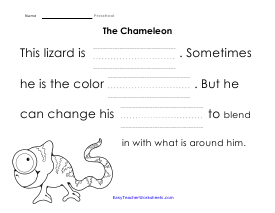These preschool writing worksheets are set up to help students be creative and do things that they will enjoy. Many of the activities ask students about their personal experiences which is what students at this level love to share openly. These worksheets progress from coloring to sentence completion, then on to short sentence writing which is a huge win if we can get them there in preschool. You can move on to the kindergarten writing worksheets if you have advanced students. These students will be able to write a short (five word) original sentence. Leave a positive impression about writing on your preschool students by giving them the gift of satisfying worksheets. Just scroll down and print till your heart is content. They simply want to unleash their imaginations, which the 15-worksheet series of lessons encourage. One worksheet prompts preschoolers to pay homage to mom like "I want to tell you…" and "thank you for…" This worksheet sets the writing stage for progress to be made in grade school.
Printable Preschool Writing Worksheets
Click the buttons to print each worksheet and answer key.




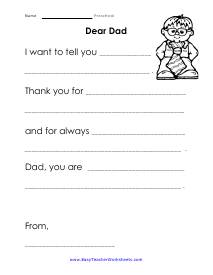


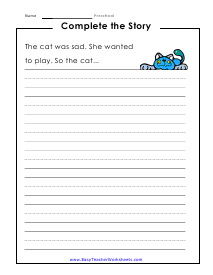

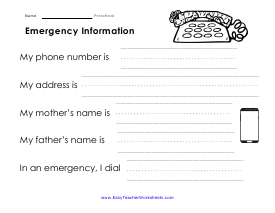


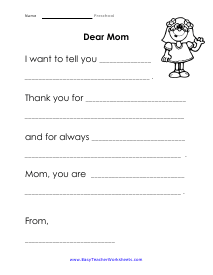

What Pre-Writing Skills Should Preschoolers Master?
At the preschool level this is the first time we have an opportunity to help students develop the skills required to simply write. There are a number of techniques that we have seen be very successful for preschool age children. I find that coloring and story telling is a great lead in. The coloring with crayons helps students develop their fine motor readiness and coloring helps students learn the concept of confining their hand movements to certain areas. The expression comes in the form of story telling. We would encourage teachers to model writing what students say in their story. This helps students understand that they are being heard and their thoughts are being expressed through writing which is a powerful concept for youngsters to grasp. I also find that having them trace and draw images that mirror something else can really help, this leads to penmanship towards letter development at the preschool level. When preschoolers begin the education trek, you want to inspire them with creative lessons that discuss the art of writing. At this stage of their lives, preschoolers are not interested in learning about technical topics.
Before a child can hold a pencil and write a perfect B, they spend a lot of time developing gross motor skills that enable them to grip that pencil and move their wrist to scribble random lines.
Preschoolers practice activities that lead to pencil control and letter formation. Developing these writing skills is essential; luckily, there are a lot of simple activities that can be done at home or school that help your preschooler master those skills.
What are Pre-Writing Skills?
These fundamental experiences help prepare children for writing when they become developmentally ready. These skills enhance the child’s pincer grip and ability to hold a pencil and use it to scribble, draw, write, and color.
Why are They So Important?
They are crucial for preschoolers as they develop the ability to firmly hold a pencil and confidently move it to produce legible writing. If these skills are underdeveloped, they can cause frustration and fatigue due to the child’s inability to write fluently and keep up with other students in the class. Poor academic performance and self-esteem can be avoided by helping preschoolers master their ability with basic readiness tasks.
Examples of Pre-writing Skills
These are a few pre-writing skills that preschoolers need help developing before they can start formal writing:
- Good Posture
- Gross motor control
- Bilateral coordination and core control
- Good pencil grasp
- Fine motor control
- Ability to form basic patterns and shapes (lines, squares, X, etc.)
Essentials for Developing Pre-writing Skills
1. Pencil Grip: How the child holds the pencil and the effort it takes them to move it on the paper, putting enough pressure using hands and fingers for accurate and controlled pencil movement.
2. Hand-eye Coordination: Directing and controlling the hands after processing the information from the eyes.
3. Upper Body Strength: The shoulder of the dominant hand provides strength and firmness for a controlled hand movement allowing good pencil control.
4. Bilateral Integration: Using both hands with the dominant hand leading and the other hand helping by holding the paper.
5. Object Manipulation: Manipulating (holding and moving) tools such as pencils and scissors and controlling everyday tools like a hairbrush, toothbrush, and cutlery.
6. Hand Dominance: Consistently using the dominant hand for each task, gradually improving its performance and allowing the development of fine skills.
7. Visual Perception: Cognitive ability (related to the brain) to interpret and comprehend visual images, including numbers and letters.
8. Hand Division: the pincer grip, or moving the thumb, index, and the middle finger for holding things, allowing the fourth and little finger tucked to stabilize the other fingers without participating.
Activities for Improving Pre-Writing Skills
1. Threading and lacing using multiple-sized laces and holes.
2. Engage the kids in play-doh activities, letting them roll the play-doh with their hands or with a rolling pin.
3. Use a small scissor to cut out basic shapes. Paste the cutouts together to make new pictures of objects such as cars, trucks, houses, or robots.
4. Use tongs or tea bag squeezers to pick up small objects.
5. Draw or write upwards, downwards, and backwards movements on a vertical surface.
6. Engage kids in everyday activities requiring finger strength. For example, opening the lids of jars and containers.
7. Practice drawing the pre-writing shapes (★, ↙, ∩, ∇, @, +, ?, ✓, \, /, X, etc.)
8. Sing songs like Itsy bitsy Spider and act them out using finger movements.
9. Create crafts using empty bottles, old boxes, paper, wool, and glue or tape.
10. Play with Legos and make new objects.
How Can You Improve the Pre-Writing Skills of Your Preschooler?
Determine the dominant hand and reinforce its use in performing precision tasks. Encourage activities involving a lot of grasping and moving small objects to enhance the pincer grip and movement of the wrist muscles. And remember, praise the child when they remain persistent in performing a difficult activity.


